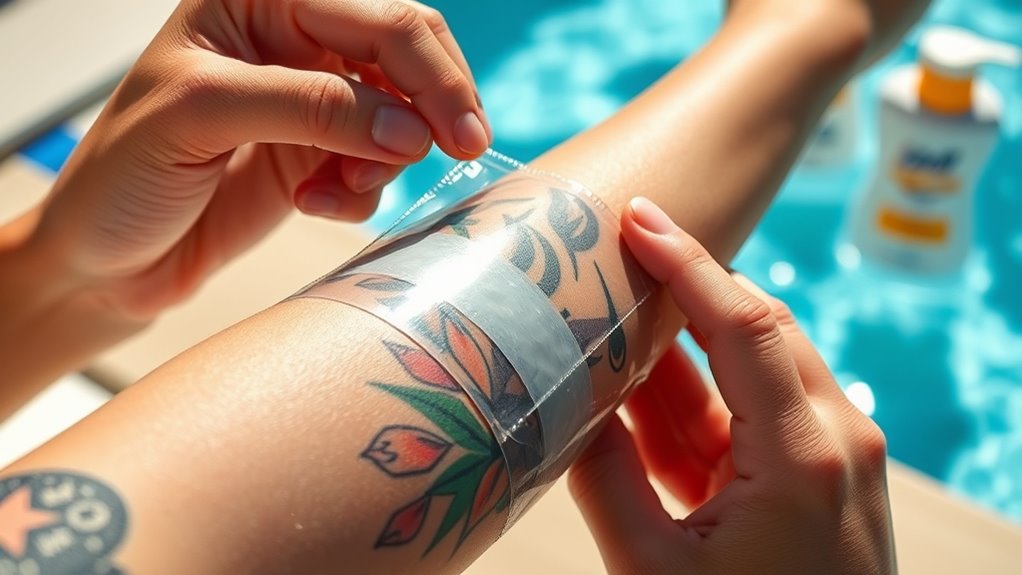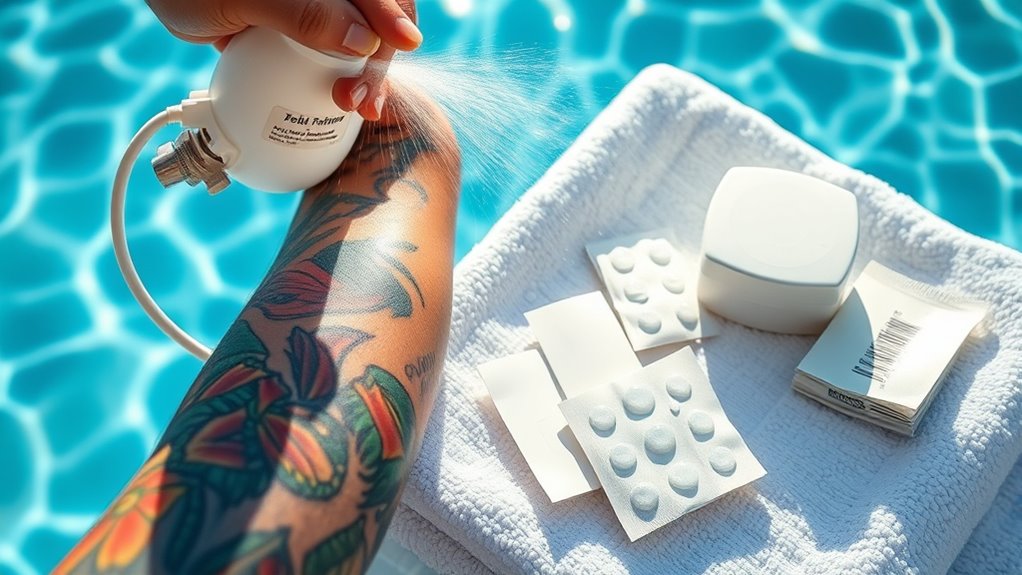To waterproof your tattoo before swimming, initially apply a medical-grade waterproof bandage like Tegaderm, extending one inch beyond the tattoo edges and pressing firmly to eliminate air bubbles. Next, use a specialized tattoo balm with beeswax 30 minutes before swimming to create a supplementary barrier. Ultimately, spray on a waterproof protectant and let it dry completely before entering water. Remember to thoroughly clean and dry the area after swimming to maintain your ink’s vibrancy and integrity.
Apply a Medical-Grade Waterproof Bandage

When protecting your fresh tattoo before swimming, a medical-grade waterproof bandage provides the most reliable defense against water exposure. Products like Tegaderm, Saniderm, or Aquaphor bandages offer superior skin protection while creating a waterproof barrier.
For proper bandage application, initially clean and completely dry your tattoo area. Remove the backing from the bandage and position it to extend at least one inch beyond all edges of your tattoo. Press firmly from the center outward to eliminate air bubbles that could trap moisture. Smooth the adhesive edges to create a watertight seal.
Test the bandage’s security by gently pressing the edges before swimming. You’ll need to replace it after 3-4 hours of water exposure, as extended soaking may compromise the adhesive. Always inspect the seal frequently while swimming to guarantee continued protection.
Create a Protective Barrier With Specialized Tattoo Balm
Although waterproof bandages offer superior protection, specialized tattoo balms provide an effective alternative for creating a water-resistant barrier over your healing ink. Apply a thin, even layer of high-quality tattoo balm 30 minutes before swimming to allow adequate absorption time. These products contain water-repellent ingredients like beeswax and natural oils that form a protective seal without suffocating your skin.
Among the tattoo balm benefits is their ability to simultaneously moisturize and shield your tattoo from chlorine and saltwater. For ideal tattoo care, reapply immediately after exiting the water and thoroughly pat dry. Choose balms specifically formulated for tattoo protection rather than standard moisturizers. Keep in mind that while balms create an effective barrier, they don’t provide complete waterproofing, so limit your water exposure to preserve your artwork’s integrity.
Shield Your Ink With Waterproof Spray and Proper Aftercare

Waterproof sprays represent another valuable option in your tattoo protection arsenal. These specialized products create an invisible barrier that prevents water penetration while still allowing your skin to breathe. When incorporating swimming precautions into your tattoo maintenance routine, apply the spray evenly across the tattoo and allow it to dry completely before exposure to water.
| Product Type | Protection Duration | Application Frequency |
|---|---|---|
| Silicone-Based | 4-6 hours | Once before swimming |
| Polymer Shield | 2-3 hours | Every 2 hours |
| Medical Grade | 5-8 hours | Once daily |
| Natural Formula | 1-2 hours | Before each swim |
| Zinc Oxide | 3-4 hours | Every 3 hours |
After swimming, immediately rinse your tattoo with clean, fresh water and pat dry with a clean towel. Reapply your regular tattoo moisturizer to prevent drying and maintain vibrant colors.
Frequently Asked Questions
How Long Should I Wait After Getting a Tattoo Before Swimming?
Wait at least 2-4 weeks before swimming after getting a tattoo. Your tattoo healing process requires this time to guarantee the skin barrier completely reforms. Most artists recommend avoiding submerging your new ink for a minimum of two weeks in pools and up to four weeks for ocean swimming. This swimming timeline varies based on the tattoo’s size, placement, and how quickly you heal. Always follow your specific artist’s aftercare instructions.
Can Chlorine Permanently Damage a Healed Tattoo?
Chlorine won’t permanently damage your healed tattoo from a single exposure, but repeated chlorine exposure can contribute to tattoo fading over time. The chemical breaks down ink particles gradually, particularly affecting colored inks. You’ll notice this effect more if you’re a frequent swimmer or hot tub user. To minimize damage, rinse thoroughly with fresh water immediately after swimming and apply moisturizer to counteract chlorine’s drying effects. Sunscreen before pool time provides extra protection against combined chlorine and UV damage.
Are Natural Bodies of Water Safer Than Pools for Tattoos?
Natural water vs. pools each present different risks to your tattoo. While pools contain chlorine that can fade ink over time, natural bodies of water harbor bacteria that might infect a healing tattoo. During the tattoo healing process, you’ll want to avoid both environments entirely. Once healed, natural water is slightly less damaging than chlorinated pools, but you’re still exposing your artwork to elements that can gradually diminish its vibrancy and clarity.
Should I Reapply Waterproofing Products During Extended Water Activities?
Yes, you absolutely should reapply waterproof products during extended water activities. Most waterproof barriers break down after 1-2 hours of continuous exposure. For proper swimming precautions, exit the water every 60-90 minutes to dry your tattoo and apply a fresh layer. Watch for signs of product degradation like edges peeling or a slick feeling. Don’t wait until the protection fails completely—maintaining consistent coverage is essential for protecting your investment during long swimming sessions.
Will Sunscreen Interfere With Tattoo Waterproofing Products?
Sunscreen can interfere with tattoo waterproofing products if applied incorrectly. You’ll want to apply your waterproofing product initially and let it dry completely. Then, carefully apply sunscreen over it, avoiding rubbing too vigorously. Some sunscreen ingredients may break down waterproof barriers, especially chemical filters. For tattoo healing, this interaction becomes even more critical—always use mineral-based sunscreens on healing tattoos and wait until your artist confirms it’s safe to use waterproofing products.



